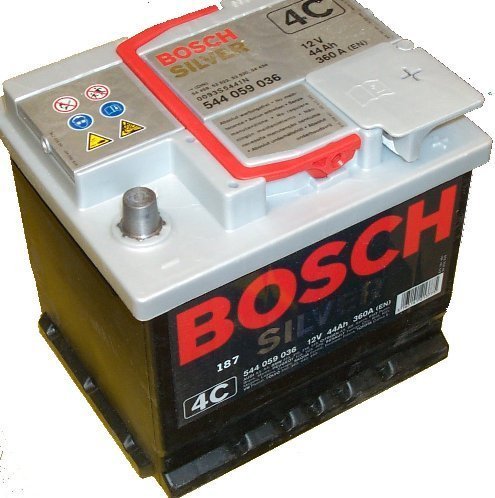|
|
Battery (additional information)

Function
The six cells of a 12V-battery contain two sets of plates. In the charged state the set of plus-plates obtains a framework of hard-lead, and in this, the red-brown lead-dioxide (PbO2). In the minus
set of plates, the framework contains a light grey lead-paste. The interlaced positive and negative plate-sets are kept apart from each other by separators. All the plates of a cell are immersed in an electrolyte which
consists (in the charged state) of distilled water and 37% sulfuric acid (H2SO4). Due to the fact that, within the electro-chemical tension series, lead and lead-dioxide build up
a tension difference of approx. 2 volts, six cells have to be switched in series for a 12V-battery.
Newly bought batteries should never
be more than 1 year old |
The ageing of a battery has a lot to do with the sulfation of the plates with each discharging process and is also influenced strongly by its movement in the vehicle. Because lead or lead-oxide is only a filler in the
framework, it can become loose through driving. Liquid-porous pocket-separators prevent the subsiding and thus, an early battery defect through short circuiting. The plates can reach down to the floor of the battery
casing. In brand-new batteries, and through longer storage, there is a risk of a deep discharge, which can destroy a battery at a very early age.
High temperatures and discharging below 12 V
should be avoided. |
More often than the damage through short circuiting, is the layer development which causes the untimely ageing of the battery in modern vehicles where high demands are made of the on-board electrical system. Not
only during the starting of the engine is the battery so strongly charged- and discharged again, but also in further operations, so that in the top half of the battery the very much weaker-, and in the bottom half, the very
much stronger concentration of sulfuric acid is formed. This also leads to sludge build-up and with it, to a very untimely destruction. Although there are already remedies which prevent the segregation, eg., by
circulation, either they are not yet effective enough, or they are not yet in the mass-production.
Never top up with tap-water:
higher discharge rate through salts,
shorter life through lime. |
Jump starting
When jump-starting, a great deal of precaution is also necessary to avoid possible larger damage. It is important basically, to follow the manufacturer's instructions and data. Quite often, the handling error can be
reconstructed by diagnosing the resulting damage. This can possibly, have a negative influence on the guarantee. The critical moment is actually, then when both vehicles are running and one considers the problem
to be solved. When disconnecting the jump-leads, voltage peaks can develop. To avoid this, it is advisable, for the short time of disconnection, to switch on all available consumers in the vehicle which has the flat
battery.
Deeply discharged battery on a charger
as soon as possible. |
Disposal
The biggest problems and the greatest danger for persons is of course, the battery acid. The metal-alloys used for the poles, the cell-connectors, the grids and also the lead from the lead sulphate and from the lead
oxide are to be recycled. The separators and the casing are easily recycled, once they have been freed from any rest-acids. 08/11
| Smoking, open flame and sparking prohibited. |
|
|